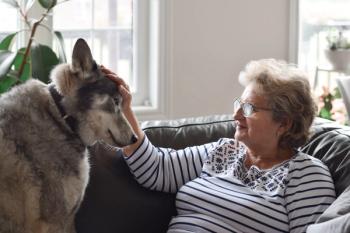
6 future trends in veterinary hospital design
From private clinics to teaching hospitals, these are the trends shaping the functionality of veterinary hospitals.
Roy Abernathy, AIA, a principal at FWAJDB Architects in Atlanta, is keeping busy these days, designing private practice hospitals from 1,200 square feet all the way to 640,000 square feet. But Abernathy took a few moments to share with us by phone some of the trends he's seeing in hospitals—large and small—that may affect the next practice of your dreams. Are you taking notes? You should.
For more advice, watch for links to articles and live events throughout this article.
1. Group the learners. Teaching hospitals, like the recently opened facility at the University of Guelph in Canada, are designed so that veterinary students can observe key techniques and hold regular Q&A sessions with instructors.
More and more private practices are also using the "rounds" approach these days. The idea is to build a central location for the owners, associates, and team members to meet and discuss the schedule and workload for the day, Abernathy says. Rooms are large enough for everyone to stand in, and other smaller rooms look on exam rooms with one-way glass that let managers critique and make suggestions to doctors and team members to improve client compliance and clinical recommendations.
Learn more about exam room and treatment area design at Veterinary Economics' Hospital Design Conference Aug. 25 to 27 in Kansas City.
2. Run home to rehab. More practices have rehabilitation space and equipment on their mind when they refurbish existing hospitals or build new. "Once a surgery's performed at a teaching hospital far away, an animal can come home to the referring practice for rehab," Abernathy says. It makes for better, more individualized care for the pet, and convenience for the client.
Click here to read
3. Tackle tech. Some up-and-coming technology is poised to become standard in most hospitals, if paperless-practice proponents get active. "We're looking at giving a tablet computer to clients to fill out information in real time, with no typing by a team member and no paper to be transferred," Abernathy says. Also on the horizon: doctors who use sensory telemetry to follow patients' vitals from anywhere in the hospital, thanks to wireless technology.
On the equine side, veterinarians are using technology to go where the horse is, rather than requiring a stressful drive and visit to the facility. The University of Guelph is providing more tertiary care at racetracks with a new mobile endoscopy unit.
Click here to read
Click here to read
Register to learn about integrating technology and equipment at the Hospital Design Conference.
4. Find your specialty, err, specialties. More hospitals are building special rooms for procedures: dentistry came first, followed now by cardiology, neurology, and more. "No one wants to be the first cardiologist in the building," Abernathy says—it's hard to launch a specialty service without preplanning the space and equipment needed the board-certified expert will need when she shows up to work.
5. Build a room of one's own. In some hospitals, doctors have two choices: be in the exam room and treatment area, or hang out far from the action in an upstairs or back-of-the-office hospital. Abernathy says "touch-down" offices offer doctors a quiet place to talk to colleagues and clients amidst the chaos of back-room treatment. These small rooms near treatment and exam areas are smaller than regular offices: six by eight square feet, rather than 10 by 14 square feet. They provide just enough room for a desk, a chair or two, and a window to let doctors see the treatment area to react to emergencies. "Veterinarians can share one of these, with a computer to call up records, and a door to shut and talk to clients," Abernathy says.
6. Make a good impression. Abernathy says the trends in Veterinary Economics and in the world of veterinary architecture point to more inviting waiting areas, with receptionists not cordoned off behind a window or high counter but positioned more accessibly in the waiting area. "It's a different type of lobby today," Abernathy says. "It's even more of a retail environment, with room for a few items on the shelf and maybe a monitor about the animals coming in today."
Click here for photos of appealing veterinary hospital waiting areas.
Abernathy is optimistic about the growth of veterinary medicine as he learns of residencies and internships being offered and hears practice owners complain they can't find enough associates. There's room to grow—and architects like Abernathy are there to help make the rooms for it.
Newsletter
From exam room tips to practice management insights, get trusted veterinary news delivered straight to your inbox—subscribe to dvm360.




